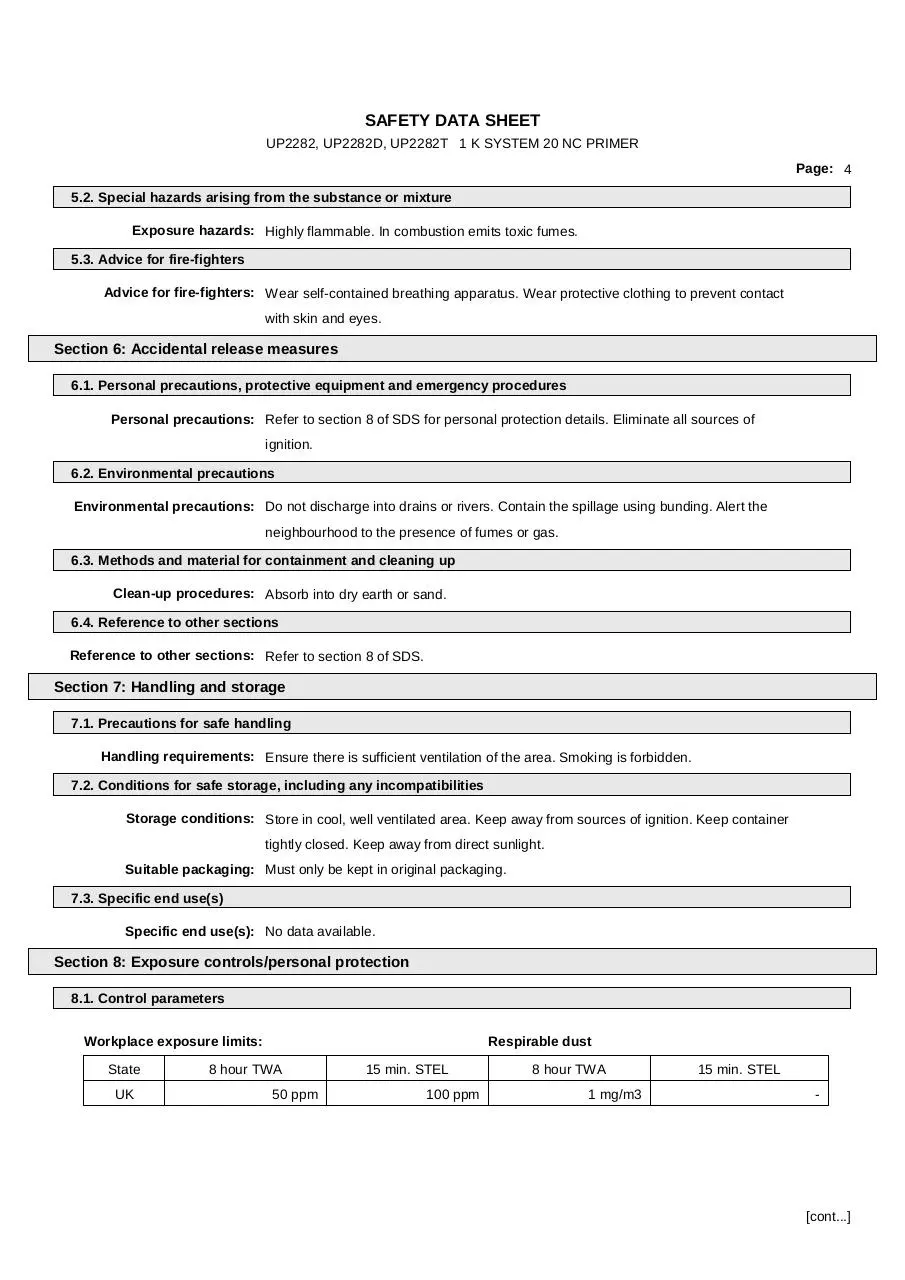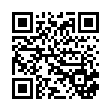SDS UPOL 2282 1k System 20 NC Primer (PDF)
File information
Author: richard burkhill
This PDF 1.4 document has been generated by pdfFactory www.pdffactory.com / pdfFactory 4.50 (Windows Server 2008 R2 Enterprise x64), and has been sent on pdf-archive.com on 01/03/2016 at 15:39, from IP address 73.183.x.x.
The current document download page has been viewed 675 times.
File size: 37.55 KB (8 pages).
Privacy: public file





File preview
SAFETY DATA SHEET
UP2282, UP2282D, UP2282T 1 K SYSTEM 20 NC PRIMER
Page: 1
Compilation date: 06/12/2011
Revision date: 16/07/2012
Revision No: 5
Section 1: Identification of the substance/mixture and of the company/undertaking
1.1. Product identifier
Product name: UP2282, UP2282D, UP2282T 1 K SYSTEM 20 NC PRIMER
Product code: S2028/G
1.2. Relevant identified uses of the substance or mixture and uses advised against
Use of substance / mixture: PAINT PRODUCT CONTAINING NITROCELLULOSE AND A MIXTURE OF SOLVENTS
1.3. Details of the supplier of the safety data sheet
Company name: U-POL US Inc.
630 Selvaggio Drive
Suite 300
Nazareth
PA 18064
USA
Tel: 1-800-340-7824
Fax: 1-800-787-5150
Email: technical:u-pol.com
1.4. Emergency telephone number
Emergency tel: 1-800-424-9300 (CHEMTREC)
Section 2: Hazards identification
2.1. Classification of the substance or mixture
Classification under CHIP: F: R11; Xi: R36; -: R66; -: R67
Classification under CLP: STOT SE 3: H336; Eye Irrit. 2: H319; Flam. Liq. 2: H225; Skin Irrit. 2: H315
Most important adverse effects: Highly flammable. Irritating to eyes. Repeated exposure may cause skin dryness or
cracking. Vapours may cause drowsiness and dizziness.
2.2. Label elements
Label elements under CLP:
Hazard statements: H225: Highly flammable liquid and vapour.
H315: Causes skin irritation.
H319: Causes serious eye irritation.
H336: May cause drowsiness or dizziness.
Signal words: Danger
Hazard pictograms: GHS02: Flame
GHS07: Exclamation mark
[cont...]
SAFETY DATA SHEET
UP2282, UP2282D, UP2282T 1 K SYSTEM 20 NC PRIMER
Page: 2
Precautionary statements: P280: Wear.
P303+361+353: IF ON SKIN (or hair): Remove immediately all contaminated clothing.
Rinse skin with.
P304+340: IF INHALED: Remove victim to fresh air and keep at rest in a position
comfortable for breathing.
P305+351+338: IF IN EYES: Rinse cautiously with water for several minutes. Remove
contact lenses, if present and easy to do. Continue rinsing.
P312: Call a POISON CENTER or doctor if you feel unwell.
P370+378: In case of fire: Use for extinction.
Label elements under CHIP:
Hazard symbols: Highly flammable.
Irritant.
Risk phrases: R11: Highly flammable.
R36: Irritating to eyes.
R66: Repeated exposure may cause skin dryness or cracking.
R67: Vapours may cause drowsiness and dizziness.
2.3. Other hazards
PBT: This substance is not identified as a PBT substance.
Section 3: Composition/information on ingredients
3.2. Mixtures
Hazardous ingredients:
ACETONE
EINECS
200-662-2
CAS
67-64-1
CHIP Classification
CLP Classification
Percent
F: R11; Xi: R36; -: R66; -: R67
Flam. Liq. 2: H225; Eye Irrit. 2: H319;
STOT SE 3: H336; -: EUH066
10-30%
-: R10; -: R66; -: R67
Substance with a Community
workplace exposure limit.
Flam. Liq. 3: H226; STOT SE 3: H336;
-: EUH066
10-30%
N-BUTYL ACETATE
204-658-1
123-86-4
[cont...]
SAFETY DATA SHEET
UP2282, UP2282D, UP2282T 1 K SYSTEM 20 NC PRIMER
Page: 3
4-CHLORO BENZOTRIFLUORIDE
202-681-1
98-56-6
-: R10; Xi: R36/37/38; -: R52
-
1-10%
2-BUTOXYETHYL ACETATE
203-933-3
112-07-2
Xn: R20/21
Acute Tox. 4: H332; Acute Tox. 4: H312
1-10%
71-36-3
-: R10; Xn: R22; Xi: R37/38; Xi:
R41; -: R67
Flam. Liq. 3: H226; Acute Tox. 4: H302;
STOT SE 3: H335; Skin Irrit. 2: H315;
Eye Dam. 1: H318; STOT SE 3: H336
1-10%
Flam. Liq. 3: H226
1-10%
BUTAN-1-OL
200-751-6
2-METHOXY-1-METHYLETHYL ACETATE
203-603-9
108-65-6
-: R10
Substance with a Community
workplace exposure limit.
Section 4: First aid measures
4.1. Description of first aid measures
Skin contact: Wash immediately with plenty of soap and water. Remove all contaminated clothes and
footwear immediately unless stuck to skin.
Eye contact: Bathe the eye with running water for 15 minutes. Transfer to hospital for specialist
examination.
Ingestion: Do not induce vomiting. If conscious, give half a litre of water to drink immediately.
Transfer to hospital as soon as possible.
Inhalation: Remove casualty from exposure ensuring one's own safety whilst doing so. Transfer to
hospital as soon as possible.
4.2. Most important symptoms and effects, both acute and delayed
Skin contact: There may be irritation and redness at the site of contact.
Eye contact: There may be pain and redness.
Ingestion: There may be soreness and redness of the mouth and throat. Nausea and stomach
pain may occur.
Inhalation: There may be irritation of the throat with a feeling of tightness in the chest. Drowsiness
or mental confusion may occur.
4.3. Indication of any immediate medical attention and special treatment needed
Immediate / special treatment: Not applicable.
Section 5: Fire-fighting measures
5.1. Extinguishing media
Extinguishing media: Carbon dioxide. Alcohol or polymer foam. Dry chemical powder.
[cont...]
SAFETY DATA SHEET
UP2282, UP2282D, UP2282T 1 K SYSTEM 20 NC PRIMER
Page: 4
5.2. Special hazards arising from the substance or mixture
Exposure hazards: Highly flammable. In combustion emits toxic fumes.
5.3. Advice for fire-fighters
Advice for fire-fighters: Wear self-contained breathing apparatus. Wear protective clothing to prevent contact
with skin and eyes.
Section 6: Accidental release measures
6.1. Personal precautions, protective equipment and emergency procedures
Personal precautions: Refer to section 8 of SDS for personal protection details. Eliminate all sources of
ignition.
6.2. Environmental precautions
Environmental precautions: Do not discharge into drains or rivers. Contain the spillage using bunding. Alert the
neighbourhood to the presence of fumes or gas.
6.3. Methods and material for containment and cleaning up
Clean-up procedures: Absorb into dry earth or sand.
6.4. Reference to other sections
Reference to other sections: Refer to section 8 of SDS.
Section 7: Handling and storage
7.1. Precautions for safe handling
Handling requirements: Ensure there is sufficient ventilation of the area. Smoking is forbidden.
7.2. Conditions for safe storage, including any incompatibilities
Storage conditions: Store in cool, well ventilated area. Keep away from sources of ignition. Keep container
tightly closed. Keep away from direct sunlight.
Suitable packaging: Must only be kept in original packaging.
7.3. Specific end use(s)
Specific end use(s): No data available.
Section 8: Exposure controls/personal protection
8.1. Control parameters
Workplace exposure limits:
State
UK
Respirable dust
8 hour TWA
50 ppm
15 min. STEL
100 ppm
8 hour TWA
1 mg/m3
15 min. STEL
-
[cont...]
SAFETY DATA SHEET
UP2282, UP2282D, UP2282T 1 K SYSTEM 20 NC PRIMER
Page: 5
Hazardous ingredients:
ACETONE
Workplace exposure limits:
State
Respirable dust
8 hour TWA
UK
15 min. STEL
8 hour TWA
15 min. STEL
1210 mg/m3
3620 mg/m3
-
-
724 mg/m3
966 mg/m3
-
-
25 ppm
-
-
-
20 ppm
50 ppm
-
-
-
154 mg/m3
-
-
548 mg/m3
-
-
N-BUTYL ACETATE
UK
4-CHLORO BENZOTRIFLUORIDE
UK
2-BUTOXYETHYL ACETATE
UK
BUTAN-1-OL
UK
2-METHOXY-1-METHYLETHYL ACETATE
UK
274 mg/m3
8.2. Exposure controls
Engineering measures: Ensure there is sufficient ventilation of the area. Ensure lighting and electrical
equipment are not a source of ignition.
Respiratory protection: Compressed airline breathing apparatus (EN139).
Hand protection: Nitrile gloves.
Eye protection: Face-shield.
Skin protection: Protective clothing with elasticated cuffs and closed neck.
Section 9: Physical and chemical properties
9.1. Information on basic physical and chemical properties
State: Liquid
Colour: Grey
Odour: Aromatic
Evaporation rate: Moderate
Oxidising: Non-oxidising (by EC criteria)
Solubility in water: Insoluble
Also soluble in: Most organic solvents.
Viscosity: Non-viscous
Kinematic viscosity: 120 poise
Boiling point/range°C: 56
Flammability limits %: lower: 1.0
upper: 6.6
Flash point°C: -20
Autoflammability°C: 490
Relative density: 1.2
VOC g/l: 549 less water and exempt compounds, 385 Total VOC
[cont...]
SAFETY DATA SHEET
UP2282, UP2282D, UP2282T 1 K SYSTEM 20 NC PRIMER
Page: 6
9.2. Other information
Other information: Not applicable.
Section 10: Stability and reactivity
10.1. Reactivity
Reactivity: Stable under recommended transport or storage conditions.
10.2. Chemical stability
Chemical stability: Stable under normal conditions.
10.3. Possibility of hazardous reactions
Hazardous reactions: Hazardous reactions will not occur under normal transport or storage conditions.
Decomposition may occur on exposure to conditions or materials listed below.
10.4. Conditions to avoid
Conditions to avoid: Direct sunlight. Heat. Sources of ignition.
10.5. Incompatible materials
10.6. Hazardous decomposition products
Haz. decomp. products: In combustion emits toxic fumes of carbon dioxide / carbon monoxide.
Section 11: Toxicological information
11.1. Information on toxicological effects
Relevant effects for mixture:
Effect
Route
Irritation
OPT
Basis
Hazardous: calculated
Symptoms / routes of exposure
Skin contact: There may be irritation and redness at the site of contact.
Eye contact: There may be pain and redness.
Ingestion: There may be soreness and redness of the mouth and throat. Nausea and stomach
pain may occur.
Inhalation: There may be irritation of the throat with a feeling of tightness in the chest. Drowsiness
or mental confusion may occur.
Section 12: Ecological information
12.1. Toxicity
Ecotoxicity values: Not applicable.
12.2. Persistence and degradability
Persistence and degradability: Only slightly biodegradable.
[cont...]
SAFETY DATA SHEET
UP2282, UP2282D, UP2282T 1 K SYSTEM 20 NC PRIMER
Page: 7
12.3. Bioaccumulative potential
Bioaccumulative potential: No data available.
12.4. Mobility in soil
Mobility: Volatile. Heavier than water.
12.5. Results of PBT and vPvB assessment
PBT identification: This substance is not identified as a PBT substance.
12.6. Other adverse effects
Other adverse effects: No data available.
Section 13: Disposal considerations
13.1. Waste treatment methods
Disposal operations: Incineration on land.
Recovery operations: Use principally as a fuel or other means to generate energy.
Disposal of packaging: Dispose of as normal industrial waste.
NB: The user's attention is drawn to the possible existence of regional or national
regulations regarding disposal.
Section 14: Transport information
14.1. UN number
UN number: UN1263
14.2. UN proper shipping name
Shipping name: PAINT
14.3. Transport hazard class(es)
Transport class: 3
14.4. Packing group
Packing group: II
14.5. Environmental hazards
Environmentally hazardous: No
Marine pollutant: No
14.6. Special precautions for user
Special precautions: No special precautions.
Tunnel code: D/E
Transport category: 2
Section 15: Regulatory information
[cont...]
SAFETY DATA SHEET
UP2282, UP2282D, UP2282T 1 K SYSTEM 20 NC PRIMER
Page: 8
15.1. Safety, health and environmental regulations/legislation specific for the substance or mixture
15.2. Chemical Safety Assessment
Chemical safety assessment: A chemical safety assessment has not been carried out for the substance or the mixture
by the supplier.
Section 16: Other information
Other information
Other information: This safety data sheet is prepared in accordance with Commission Regulation (EU) No
453/2010.
Phrases used in s.2 and 3: EUH066: Repeated exposure may cause skin dryness or cracking.
H225: Highly flammable liquid and vapour.
H226: Flammable liquid and vapour.
H302: Harmful if swallowed.
H312: Harmful in contact with skin.
H315: Causes skin irritation.
H318: Causes serious eye damage.
H319: Causes serious eye irritation.
H332: Harmful if inhaled.
H335: May cause respiratory irritation.
H336: May cause drowsiness or dizziness.
R10: Flammable.
R11: Highly flammable.
R20/21: Harmful by inhalation and in contact with skin.
R22: Harmful if swallowed.
R36/37/38: Irritating to eyes, respiratory system and skin.
R36: Irritating to eyes.
R37/38: Irritating to respiratory system and skin.
R41: Risk of serious damage to eyes.
R52: Harmful to aquatic organisms.
R66: Repeated exposure may cause skin dryness or cracking.
R67: Vapours may cause drowsiness and dizziness.
Legal disclaimer: The above information is believed to be correct but does not purport to be all inclusive
and shall be used only as a guide. This company shall not be held liable for any
damage resulting from handling or from contact with the above product.
[final page]
Download SDS-UPOL-2282-1k-System-20-NC-Primer
SDS-UPOL-2282-1k-System-20-NC-Primer.pdf (PDF, 37.55 KB)
Download PDF
Share this file on social networks
Link to this page
Permanent link
Use the permanent link to the download page to share your document on Facebook, Twitter, LinkedIn, or directly with a contact by e-Mail, Messenger, Whatsapp, Line..
Short link
Use the short link to share your document on Twitter or by text message (SMS)
HTML Code
Copy the following HTML code to share your document on a Website or Blog
QR Code to this page

This file has been shared publicly by a user of PDF Archive.
Document ID: 0000344644.